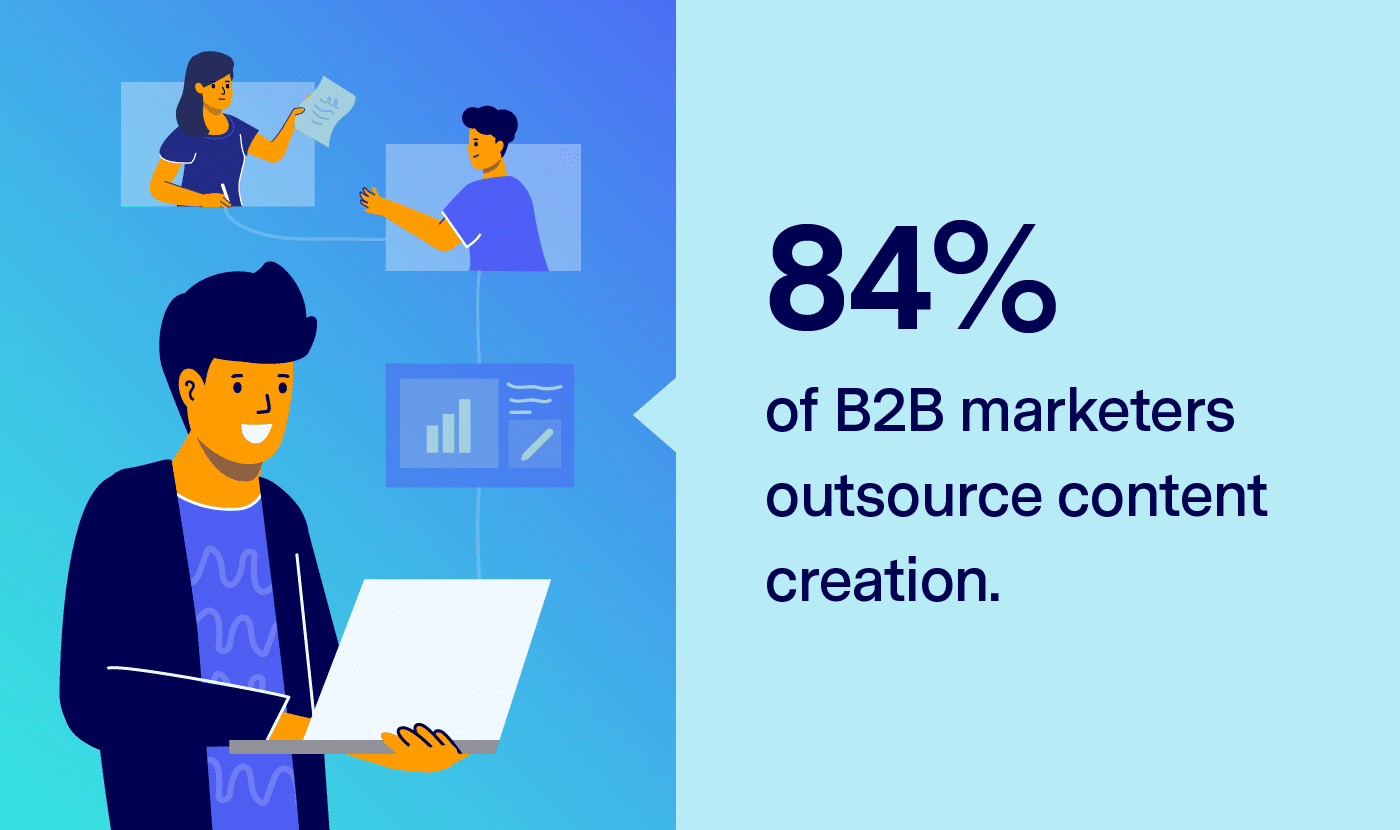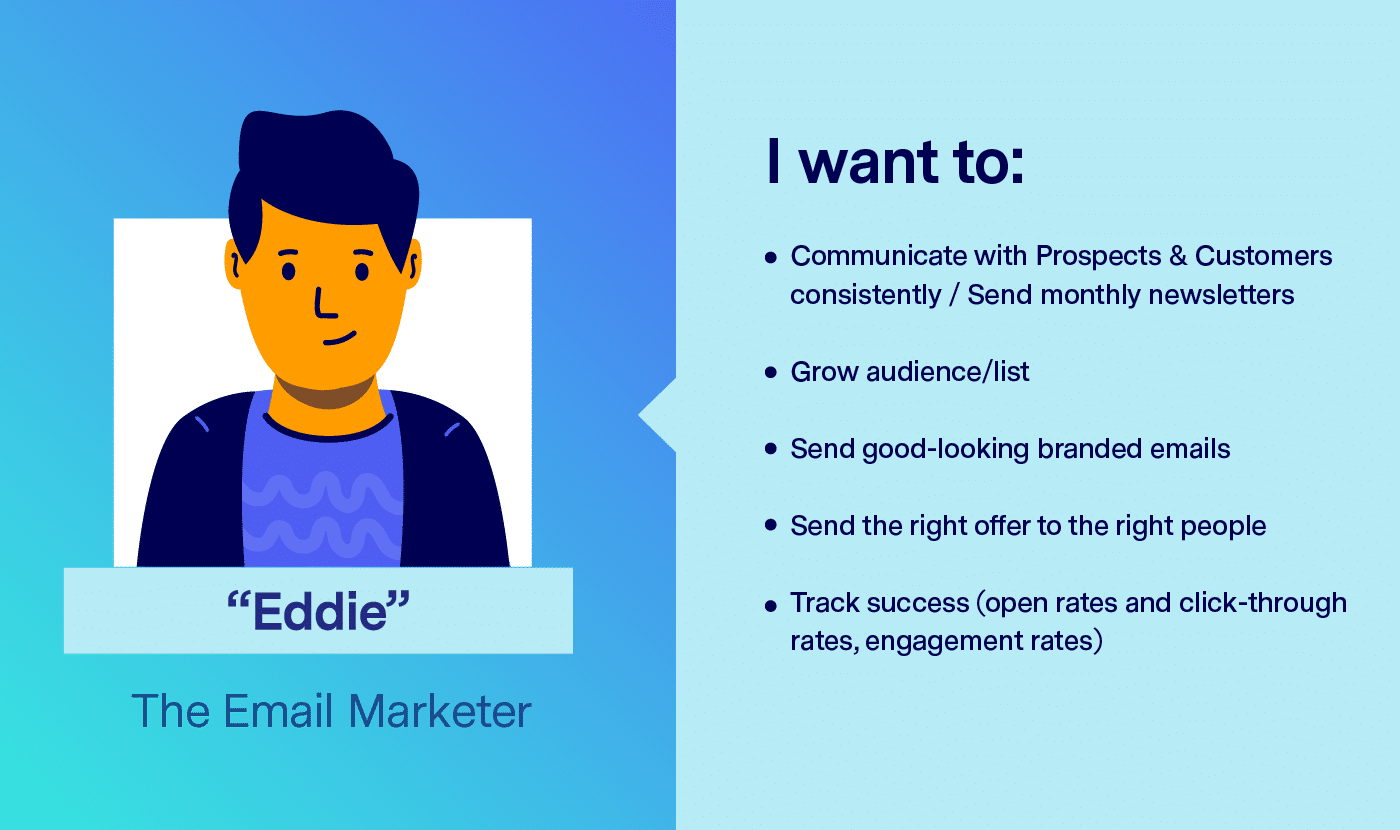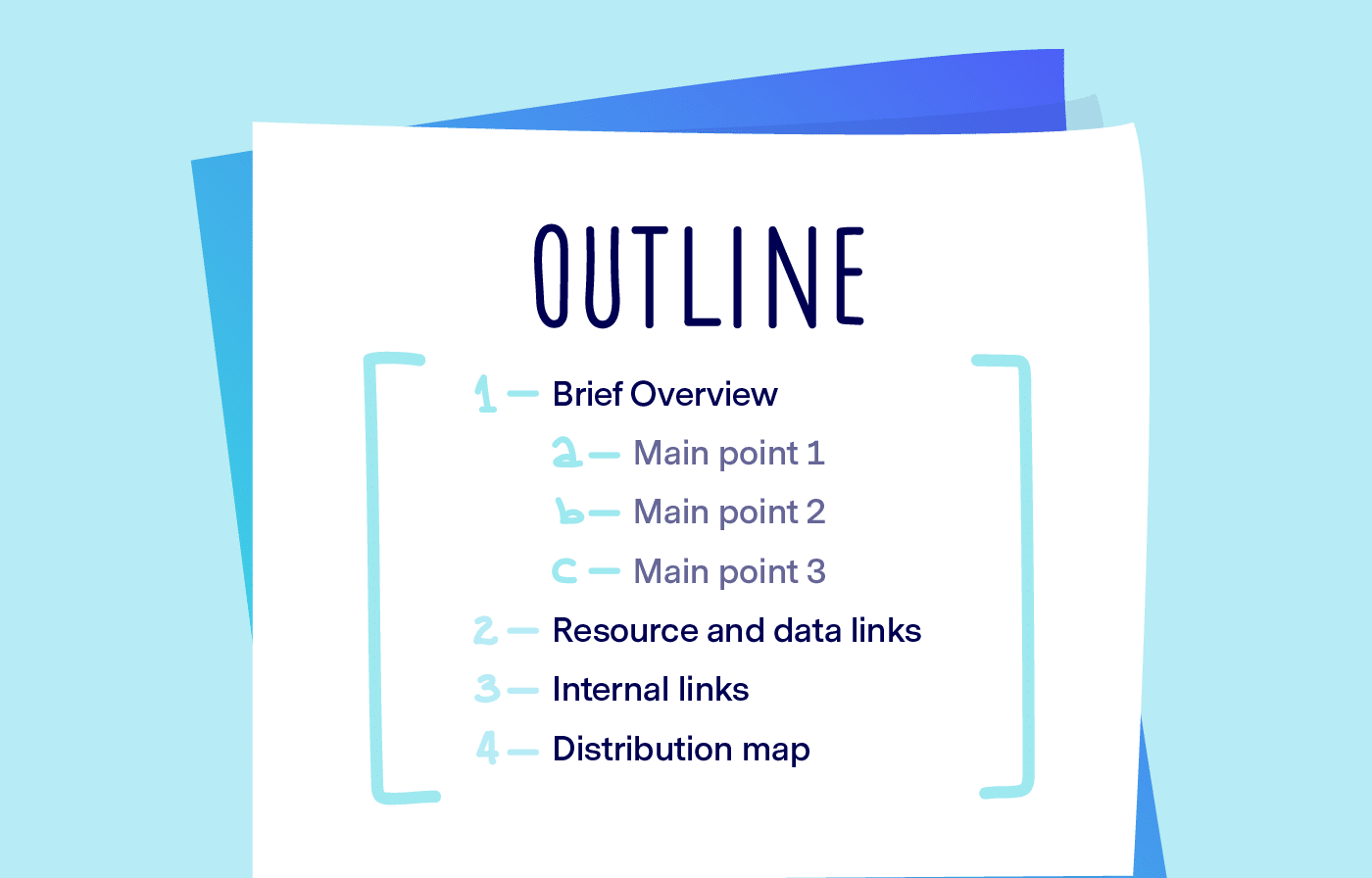Are you part of the outsourcing circle?
Outsourcing various strategies, like lead generation, SEO, or social media, aren’t uncommon, especially with small marketing teams. When you only have so many people, you have to prioritise strategies and look to outsourcing the rest for optimal productivity.
Another benefit to outsourcing is that you’re putting your strategy in the hands of experts. Instead of researching various methods and spending time, resources, and money on options you aren’t sure will yield a result, you can simply trust another, more experienced team to deliver on your goals.

Outsourcing content creation is a great way for small businesses and teams to maintain a steady stream of published content without exhausting resources. It affords them more time to focus on other strategies. However, outsourcing can be pricey, and when it comes to content creation, you want to ensure what you get back is high quality and on-message. But with 84% of B2B marketers outsourcing content creation, there’s definitely a way to strike that balance. But how?
How to Outsource Content Creation for Optimal Results
If you’ve been burned by agencies, external teams, or freelancers in the past, you could be a little gun shy when it comes to pulling the trigger on outsourced content creation. There’s a right way and tons of wrong ways to go about outsourcing. Let us help you get it right to avoid wasting money and time editing poorly developed content.
1. Create a documented content marketing strategy
When things are documented and written down (or typed), it makes everything more official. The document serves as a go-to for various team members to stay aligned and ensure everyone is working towards the same end goal. That’s why it’s extremely important to have a documented content marketing strategy.
Outlining various key points will make sure everything you create stays on course. Instead of spending time coming together on ideas and focus, everyone can simply refer to your documented strategy for a refresh. It makes things simple and keeps things on track so you can keep plugging away on other things.
There are some points you want to make sure your documented strategy includes, so let’s go down the list.
Buyer personas
You may not have this written down, but that doesn’t mean you don’t have a good idea of who your ideal customer and target audience are. Whether your company has been around for two years or ten, it’s never a bad idea to document key details about your buyers.
Many businesses have more than one ideal buyer. Make sure you outline their goals, job title, team size, who they report to, the industry they’re in, and anything else that has an impact on what solutions they may be looking for. It also helps to look at who your current customers are and take into consideration various factors about them that can inform your buyer personas.

Goals
Again, you may not already have these written down, but that doesn’t mean you don’t have a pretty good idea of what your goals are. When it comes to your content, here are some goals you should shoot for:
- Brand awareness and credibility
- SEO and obtaining more backlinks
- Lead generation
- Increased email subscribers
- More personalised content for your nurture campaigns
Whatever your goal or goals may be, make sure you know how you’ll track your content’s success. This will not only help you to determine if the content being created is doing its job, but it will also help you determine if the company or team creating the content is living up to the hype.
SEO strategy and keywords
Are you keeping track of what your audience is typing in their search queries? Knowing what your audience is searching for is the best way to understand what they’re looking for and how your content can scratch that itch.
Use tools like SEMRush or Moz to tap into the keywords you should be considering so you can create content around them. You’ll want to have pillar posts designated for your top priority keywords as well as plenty of blog content linking back to it so you can build up your internal links.

Make sure you also link back to those pillar posts in the content you get placed on outside sites, which helps you absorb those sites’ juice and get those pillar posts to rank higher over time.
Establishing your SEO strategy and keyword list and putting it in your documented content strategy will help you when it comes time to send this content out to a freelancer. It will also inform your advertising campaigns and other marketing initiatives, so do not skip this step!
Editorial calendar
Having a way to schedule your content ensures you stay on pace and on deadline. It also helps you maintain consistency, so you aren’t publishing one blog post every other week or so. If your content is to perform, it has to be consistent, and your editorial calendar will ensure you keep the published content flowing.
Decide how often you want to publish your blog content and how often you’ll be pitching ideas to other sites. How often will you be creating long-form content, whitepapers, or guides? List the various kinds of content you’ll be creating:
- Blog content
- Guest content
- eBooks
- Whitepapers and guides
- Infographics
Understanding the type of content you want to create and then working it into a schedule helps you see how each piece works towards your big-picture strategy. You can always adjust over time and once you’ve had a chance to review ROI and results.
A simple Excel sheet or Google Sheet can go a long way when creating your editorial calendar. Section off by months and days, and make sure to include content title, status, and publish date, so nothing loses steam.
Distribution plan
Speaking of losing steam, if you don’t adequately distribute your content once it’s live, consider it DOA.
The whole point of creating content is so that it can be shared with people who need it. So once you hit publish, the real fun begins.
Mapping out your distribution plan is really about knowing your audience first and foremost. You have to know the channels in which your audience is already engaged, the key terms they’re using in search enquiries, and what resources they’re after. Once you have a good idea of the most beneficial channels to be on, then you can begin distributing your content.
It’s good practice to share your newly published content on your standard social media channels:
While sharing on social media is table stakes for distribution, don’t forget to include new content in your email marketing strategy. Share content in your monthly email newsletter, or use it in targeted nurture campaigns to your audience.
However, when you’re creating more compelling, strategic content, like a gated resource, a survey, or something long-formed meant to generate leads, don’t be afraid to put some money behind it. Utilising paid advertising allows you to tap into that particular channel’s paid audience, and you can customise who sees your ads to double down on your target audience.
Start mapping out your distribution plan by listing the various channels you’ll want to distribute on. Some should include:

Then, establish which kinds of content make the most sense for each channel. For example, you won’t want to share every blog post you publish via a paid Facebook ad. That would get costly, and since it’s a blog post, the chances of generating high-quality, valuable leads from it aren’t likely.
2. Vet potential freelancers or agencies
When vetting possible freelancers or content creation agencies, first understand your needs.
- Do you simply want written content, or will you also need visual content, like videos or infographics?
- Will you need access to a professional editor?
- How much content do you need, and how often?
Your content strategy should help guide this, so revert back to your goals to determine your scope of work.
Also, don’t forget your budget. You’ll want to have an idea of what your spend threshold is, so you don’t end up going with the first agency you meet with, only to find out you’re drastically overpaying.
To find some possible resources, try the following:
- Reach out to industry peers and partners and see what they do for content creation. They may have an agency they could recommend or access to freelancers that are looking for more work.
- Check review sites, like G2 or Google My Business, and see who comes highly recommended.
- Search LinkedIn for possible freelancers open to work or content agencies.
- Consider using DIY tools such as online logo makers especially if your budget is not that big. These tools are a great resource for you to produce quality work while you save up for professional services.
3. Make a selection
Select your content creator based on which solution best fits your needs and budget requirements. Before finalising, make sure you clearly outline expectations and deliverables. And make sure you agree on cost per work or cost per piece of content.
You’ll probably be provided with some sort of agreement or contract, so make sure you review it carefully. Don’t ignore any questions or concerns you may have. Address any issues with your soon-to-be content creator or team for ultimate clarity.
4. Hold regular brainstorm sessions with your team
Some content creation agencies will brainstorm content ideas for you or even with you. If your outsourced content creation team isn’t brainstorming with you, it’s not a bad idea for your internal team to collaborate on various topics and ideas you’ll want to centre your content around.
Make sure you hold at least monthly brainstorming sessions to discuss any new company rollouts or updates, or strategy changes that will ultimately affect the content you’re putting out there. It’s also a good idea to consider possible publications you’d like to contribute your content to in these meetings.
5. Prioritise and outline
Once you have these brainstorms, condense your notes and “next steps” in a digestible format. You’ll want to reference or share them with your content creation team in your next meeting. Make sure you prioritise your ideas by sectioning out the content that is most important to create first.
Putting together an outline for each piece of content is extremely important. You may be outsourcing your content creation to a professional writer, but that doesn’t mean they’ll intuitively know exactly what you want included.
Your outline doesn’t have to be terribly detailed. It can simply provide a brief overview of what the piece of content should be about and some main points. Make sure you also include:
- Applicable keywords for each topic
- Links to resources the writer can use
- Any internal links you want included
- Data to utilise
- Your distribution plan (if it will inform the content creation in some way)

6. Send outline to freelancer
Send your outline to your freelancer or outsourced agency, and make sure you include your company’s blog guidelines (if you don’t have any, create blog guidelines!)
Make sure you also provide them with a list of competitors, so they know not to link to their content. Set a clear deadline for each piece, so you get what you need in a timely manner.
7. Review completed article
When you receive the completed article or piece of content, make sure you read it carefully to ensure it’s at the standard you expect it to be at. Review it for flow, grammar, and SEO. Once you’re done reviewing, it’s not a bad idea to also run it through an editing tool, like Grammarly, to catch any last errors.
8. Add the content to your editorial calendar
When your article is ready to go, figure out the best place for it in your editorial calendar. You might already have a month or week in mind to publish it, but adding it to an actual calendar really seals the deal and ensures it will be published.
If this article isn’t going up on your company blog but instead an outside publication of some kind, then send it off to its destination.
9. Distribute
Use your distribution plan to guide the various tactics you’ll be using to share your piece of published content. Remember, the point is to get it in front of the right people at the right time, so make sure you share it on the most applicable channels.
10. Track results
You’ll want to check in with your content from time to time to see how it’s performing. Look for things like:
- Pageviews
- Click-through rate
- Bounce rate
- Unique pageviews
- Average time on page
- Email CTR (if you’re using it in your email marketing)
This will help determine if you should change anything regarding your outsourcing process or if you should consider creating similar or different content.
Well, there you have it. We hope you find this guide to outsourcing content creation helpful. And best of luck finding the right agency or freelancer for your next content marketing endeavor!
Originally published Apr 20, 2021, updated Jan 16, 2023
